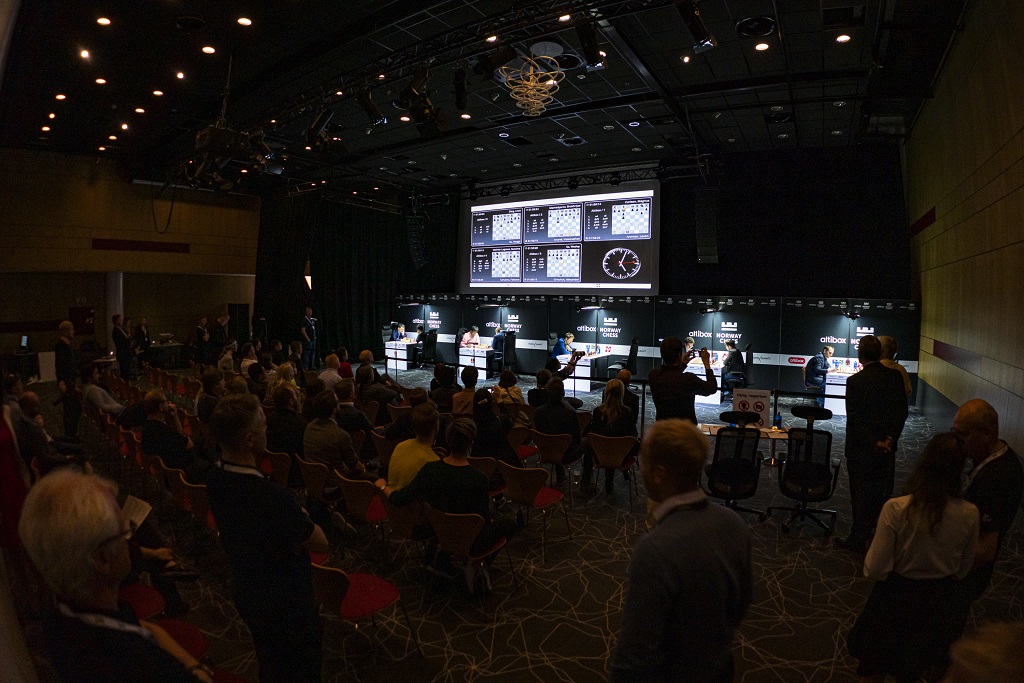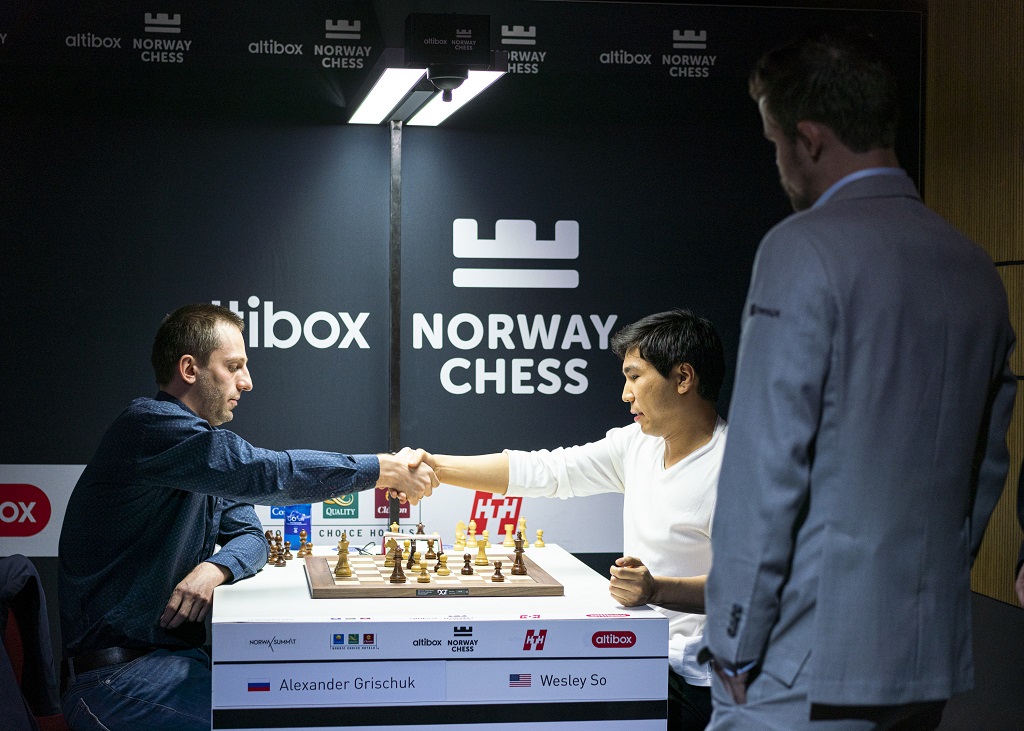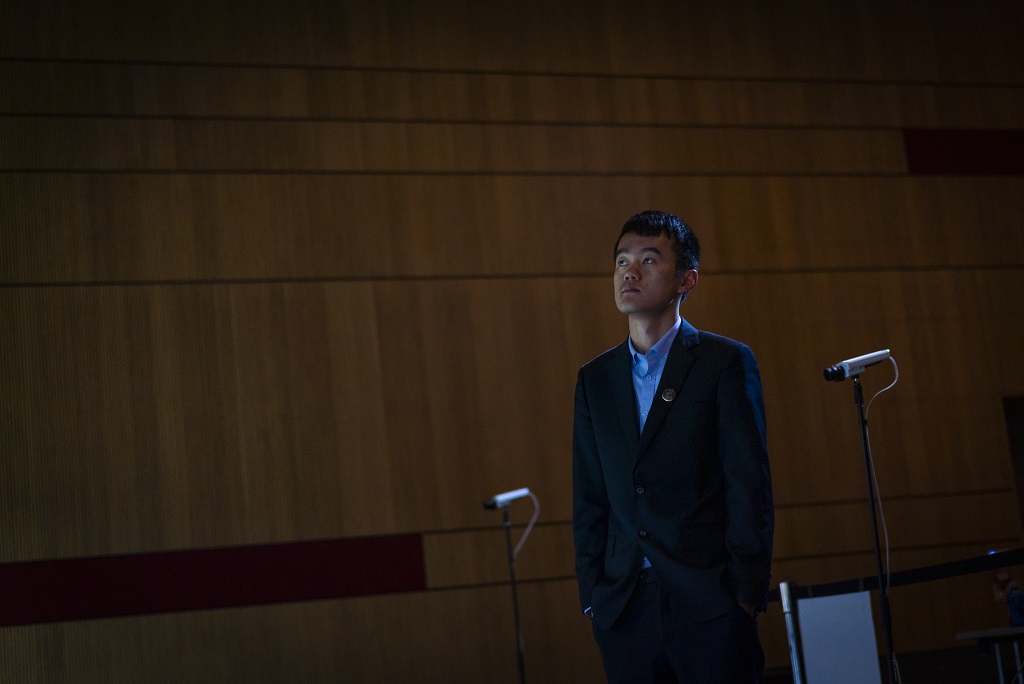


After round one finished with draws in all classical games, some chess fans started to question whether this system will in fact discourage the players from signing "strategical" draws. In the second day of action, however, four out of five games were strongly contested, but the one match-up that went down the non-fighting path was rather disheartening — Alexander Grischuk, playing White, offered Wesley So a draw after fifteen moves and under ten minutes of play. However, Grischuk lived to regret his decision, as his opponent drew with Black in the Armageddon, thus getting the extra point awarded in that phase of the confrontation.
| Rk | Player | 1 | 2 | 3 | 4 | 5 | 6 | 7 | 8 | 9 | 10 | Pts |
| 1 | S. Mamedyarov | x | 1½ | 2 | 3½ | |||||||
| 2 | Yu Yangyi | x | 1½ | 1½ | 3 | |||||||
| 3 | M. Carlsen | x | 1½ | 1½ | 3 | |||||||
| 4 | F. Caruana | ½ | x | 2 | 2½ | |||||||
| 5 | L. Aronian | ½ | x | 1½ | 2 | |||||||
| 6 | Ding Liren | ½ | x | 1½ | 2 | |||||||
| 7 | W. So | ½ | x | 1½ | 2 | |||||||
| 8 | A. Grischuk | ½ | ½ | x | 1 | |||||||
| 9 | V. Anand | 0 | ½ | x | ½ | |||||||
| 10 | M. Vachier-Lagrave | ½ | 0 | x | ½ |
Leaving Grischuk's debacle aside, the games did not disappoint. Fabiano Caruana showed some great preparation against Maxime Vachier-Lagrave, Magnus Carlsen got in trouble against Levon Aronian, Vishy Anand faced Shakriyar Mamedyarov's fearless play in the Berlin Defence and the Chinese participants — Yu Yangyi and Ding Liren — played two tense games. Four hours later, the round was over, with some surprising results on the score board.

FIDE President Arkady Dvorkovich made the first move in Levon Aronian v Magnus Carlsen | Photo: Lennart Ootes
The Armenian played the Rossolimo against Carlsen's Sicilian and the players left theory on move eight, when Levon transferred his queen from d1 to e1. Three moves later, he surprised the world champion by relocating his queen to b1 (8.♕e1, 11.♕b1)! White had won the psychological battle, inducing Black to spend over 23 minutes on move eleven (do not forget that there is no increment in Stavanger):
White started expanding on the queenside with 12.b4, while Magnus saw it necessary to look for immediate counterplay with 14...g5. Aronian had a clear edge, but it was hard to make something out of it, especially against a player who has not lost a classical game in almost eleven months. Levon increased his advantage, but missed some good chances along the way — for example, he could have gone for a shocker on move 45:
Aronian played 45.♘f5+, but 45.♖d5 would have pretty much forced his opponent to exchange the rooks with 45...cxd5 46.♘cxd5+ K♚6 47.♘xb6. After the text, White ended up getting into a rook endgame a pawn up but was never able to overcome Carlsen's defences. The draw was signed after 68 moves.
On to the Armageddon...
.jpg)
Levon Aronian had a winning edge against the world champion | Photo: Lennart Ootes
Aronian needed a win with White and repeated the Rossolimo. Carlsen, true to his "2019 style", played actively, pushing his kingside pawns and giving up an exchange (correctly) on move 26. Aronian avoided the Norwegian's deadly traps only to find himself in a losing endgame:
The material is equal, but Black's rook, bishop and passed a-pawn are too much to handle for White. Levon resigned on move 43.
.jpg)
Magnus Carlsen is a hero in Norway | Photo: Lennart Ootes
Vishy came from losing in round one against Carlsen, while Shak had defeated Caruana with the white pieces. A tense struggle with chances for both sides seemed to be en route to finish after some sort of skirmish in an unbalanced endgame...until Anand blundered, giving up a piece for nothing:
The former world champion reflected for over three minutes before playing 33.♘f7?, with the idea of responding to 33...♝c8 (forking rook and knight) with 34.♖xe5+ ♚c4 35.♘d6+, saving his piece with consecutive checks. What the legend from Madras missed was the intermezzo 33...e4, when after 34.fxg4 ♝c8 there is no way to save the material. An unfortunate mistake by the Indian ace.

A smiling Shakhriyar Mamedyarov, the leader in Stavanger | Photo: Lennart Ootes
To no one's surprise, Fabiano and Maxime explored the Najdorf Variation of the Sicilian. MVL captured the "poisoned pawn" on b2 and the players quickly got to move fifteen, when Fabiano uncorked a surprising novelty:
Instead of defending the e4-pawn with 15.♗f5 — like Ian Nepomniachtchi had recently done against Wei Yi at the Moscow Grand Prix — Caruana instantly responded with 15.♗c4. Vachier-Lagrave realized he was about to face some deep preparation by the 2018 World Championship challenger and thought for twelve minutes before capturing the central pawn with 15...♞cxe4.
Fabiano kept playing quickly, successfully handling the initiative he had gained in the opening. With a queen, a rook and four pawns per side, White was trying to make the most of his active pieces. Eventually, he exchanged down into a rook endgame in which his passer on the a-file was key. Vachier-Lagrave resigned on move sixty, in the following position:
.jpg)
Fabiano Caruana having a stroll | Photo: Lennart Ootes
The runner-up of the recent Moscow Grand Prix, Alexander Grischuk, confessed after his loss in Armageddon against Wesley So that he had looked for a quick draw in the Classical due to his disappointment regarding his round one match-up against Levon Aronian. On Tuesday, the Russian lost on time in sudden death, despite having a considerable edge on the clock a few moves prior to the end of the game. Grischuk described that loss as one of the three worst defeats he had suffered in his career.
In the Armageddon game against So, Alexander erred and had to give up his queen in the middlegame:
30.♕e1 allowed Black to penetrate with his queen and doubled rooks on the b-file after 30...♛xc2. Better was 30...♞xc5, simplifying the position — however, we should not forget that in Armageddon White is obliged to win...which explains Grischuk's decision. After this mistake, though, So got the upper hand and signed a draw after 55 moves, despite having a huge advantage on the board.

It was quick — Wesley So beat Alexander Grischuk in no time | Photo: Lennart Ootes
Both Chinese players had won their tie-breaker games in round one and, after drawing their classical encounter out of a Catalan, they went to Armageddon once again. This time, however, Yu Yangyi — the lowest rated player in Stavanger — took advantage of his compatriot's passive play in the middlegame:
Perhaps the fact that Black only needs a draw had a psychological effect on Ding Liren, who played 28...♜ac8 — instead of 28...♜cc8 or 28...♜c2 — in order to keep his rook on a8, defending the a7-pawn.
A series of exchanges followed — 29.♖xe6 ♝c4 30.♖xc3 ♝xe6 31.♖xc8+ ♝xc8 — and White was left with a pawn to the good. The presence of opposite-coloured bishops, though, gave Ding some hopes:
Nevertheless, White had no issues converting his advantage, with his active king playing a key role in the endgame. Ding Liren resigned on move 56.

China's number one Ding Liren | Photo: Lennart Ootes
The Romanian Grandmaster Constantin Lupulescu, winner of the Reykjavik Open 2019, annotated the games from round 2.
Commentary provided by Judit Polgar and Anna Rudolf